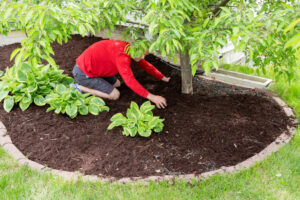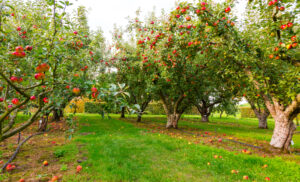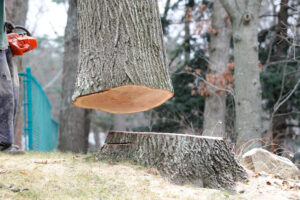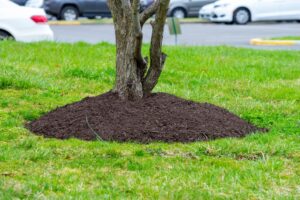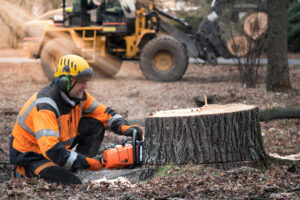Planting a healthy tree in your yard requires some planning and care. Here are some tips to ensure your tree thrives:
1. Choose the Right Tree
Make sure the tree you select is suitable for your climate, soil type, and available space. Consider the tree’s mature size and whether it will be too close to structures or power lines. This can help prevent potential damage in the future. Research the different types of trees that are well-suited for your area and select one that fits your needs and preferences.
2. Pick the Right Location
Choose a spot that gets enough sunlight and has well-draining soil. Avoid planting near sidewalks or driveways where the roots can cause damage. Make sure the location allows for plenty of growth and isn’t too close to other trees or plants.
3. Prepare the Soil
Before planting, you should start by removing any existing grass and weeds from the area. Loosen the soil to a depth of 12 to 18 inches to allow the roots of your tree to grow easily. Add organic matter such as compost or manure, and mix it into the soil well. This will help improve drainage, moisture retention, and nutrient availability.
4. Dig the Hole
When digging the hole for your tree, make sure it’s twice as wide and just as deep as the root ball. The top of the root ball should be level with the surrounding soil. This will give the tree enough room to spread its roots and ensure that the tree is planted at an adequate depth.
5. Remove the Container
Carefully remove the tree from its container or burlap, being careful not to damage the roots. If the roots are circling around the root ball, gently tease them out. If the roots are dry and brittle, soak them in water for an hour or two before planting.
6. Plant the Tree
Place the tree in the hole, but don’t cover the top of the root ball. Fill in around the sides of the hole with soil and press down gently to remove air pockets. Add a few inches of mulch around the base to help keep moisture in and weeds out. Be sure to leave a few inches between the trunk and the mulch. Water the tree well to settle the soil.
7. Mulch the Soil
Add 2 to 4 inches of mulch around the base of the tree, making sure it doesn’t touch the trunk. This will help retain moisture, prevent weeds and protect the root system from temperature extremes. Use an organic material like wood chips or shredded bark, and reapply as needed.
8. Water Regularly
Newly planted trees require a lot of water for the first few weeks to help them establish a healthy root system. Water deeply every couple of days during dry spells, and never allow the soil to dry out completely. After the first season, your tree should only need watering during summer droughts.
9. Prune Properly
Prune any broken or damaged branches, as well as any that are rubbing against each other. Avoid pruning too much at once, as this can stress the tree. Prune in late winter or early spring when the tree is dormant.
10. Monitor for Pests and Diseases
Keep an eye out for any signs of pests or diseases, such as holes in the leaves or discolored bark. Consult a professional if you notice any issues. They can help diagnose the problem and recommend treatment options.
11. Fertilize Appropriately
Depending on the type of tree, you may need to fertilize it to provide additional nutrients. Be sure to use a fertilizer that is appropriate for your tree and follow the instructions carefully. Avoid over-fertilizing, as this can damage your tree.
12. Stake if Necessary
If your tree is young or has a weak root system, it may need to be staked to prevent it from leaning or falling over. Use a soft material, such as tree straps or ties, to avoid damaging the bark. Take the stakes out after a year or two, as the tree should be strong enough to stand on its own.
13. Provide Proper Maintenance
Trees require ongoing care to stay healthy. This includes regular watering, mulching, pruning, and pest management. Follow a regular maintenance schedule to keep your tree healthy and thriving.
14. Be Patient
Trees grow slowly and it may take several years for your tree to reach its full potential. Be patient and provide the necessary care to ensure that it grows strong and healthy. With a little bit of effort, you can create a beautiful space with your newly planted tree!
Enjoy the Results
Once your tree is planted and established, you can sit back and enjoy the beauty it brings. Trees provide numerous benefits to homeowners, including increased curb appeal, improved air quality, energy conservation, erosion control, moisture retention, and nutrient availability. Taking the time to properly plant a tree is an excellent investment that will pay off in the form of a beautiful, healthy tree.
Best Trees for Planting in Eastern Tennessee
If you’re looking to plant a tree in your yard in eastern Tennessee, it’s important to choose one that is well-suited to the region’s climate and soil conditions. Here are some of the best trees for planting in Kingsport, Johnson City, Bristol, and other areas of eastern Tennessee:
Redbud: With its striking pink or purple flowers in early spring, the redbud is a popular choice for Tennessee homeowners. This small to medium-sized tree prefers well-drained soil and partial shade.
Dogwood: Another favorite in the region, the dogwood produces showy white or pink flowers in early spring. It prefers partial shade and moist, well-drained soil.
Eastern White Pine: A large evergreen tree, the Eastern white pine is well-suited to the climate and soil of eastern Tennessee. It prefers full sun and well-drained soil.
Oak: The oak tree is a classic choice for Tennessee yards. It can grow tall and provides great shade in the summer months. Oaks prefer well-drained soil and full sun.
Red Maple: This fast-growing tree has bright green summer foliage that turns scarlet in the fall. It tolerates a variety of soil types and prefers full sun to partial shade.
Sweetgum: A fast-growing tree with star-shaped leaves that turn bright red or purple in the fall. It prefers full sun and moist, well-drained soil.
Black Cherry: A medium to large tree that produces fragrant white flowers in the spring and edible fruit in the summer. It prefers full sun and well-drained soil.
Magnolia: A large evergreen tree with glossy green leaves and fragrant white flowers in the summer. It prefers full sun and well-drained soil.
When selecting a tree for your yard, be sure to do your research and choose one that is appropriate for your specific location and growing conditions. A local nursery or garden center can provide guidance on selecting the right tree for your yard.
Once you’ve chosen your tree, it’s important to properly plant and care for it. Follow the tips outlined in this article to ensure your tree thrives and provides beauty and benefits for many years to come.

